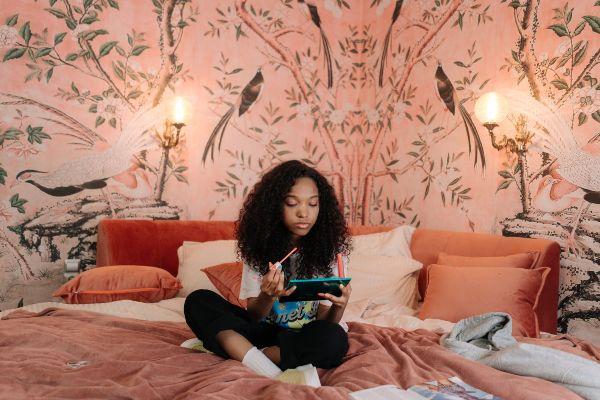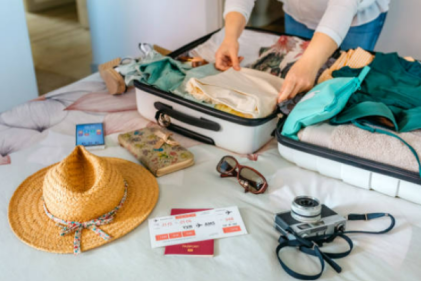Chances are, if you have a little girl or boy, they’ve been pestering and watching you do your makeup since they were young. You may have had to rescue a favourite lipstick from sticky hands and even have helped them apply ‘play’ makeup when they were small.
But what happens when the play makeup is put away and your child starts to use real makeup? What age is appropriate for them to start using it? How can we regulate it? What messaging does it send?
Around the age of 10 is when most parents report their children beginning to take an active interest in ‘grown up’ makeup, but 42% of parents believe that 12 is the age for them to start experimenting with it. Around 10 years old is when your child starts to become emotionally, socially and intellectually more independent. They begin to make more decisions for themselves about their relationships, their responsibilities and their even their physicality.
It may start with wanting a say in their clothing and gradually build up to makeup. And while 10 may seem young for them to have an interest in it, it’s not surprising given the media that we’re surrounded by these days. The beauty industry is pervasive in our lives from a young age, sending messaging about image and beauty standards, so it’s important that once your child starts on this journey that it’s approached in a mindful, healthy and regulated way.
It’s important to recognise that, like it or not, your child will eventually start to wear makeup, with or without your permission. Her friends, the media they consume, the social pressure to fit in will all influence their desire to wear it. It’s a preteen right of passage and in some cases the more forbidden it is, the more they will rebel against your restrictions on it. So guiding them through this in between time allows you to help them make good decisions and healthy boundaries for themselves and their body image. It’s understandable that you might be afraid of them attracting the wrong kind of attention that they may not be ready to handle, but by helping them moderate their journey into the beauty industry, you can help them be as prepared as possible.
Stagger makeup usage and access
When I was young, my mother cleverly classified nail polish as makeup. This harmless, not-face product made me feel grown up and glamorous while having minimal effect. I was only allowed to wear nail polish if we were going on holidays, so it became a special treat for occasions and satisfied my need to show that I was ‘grown up’.
This kind of model for makeup can be a handy one to work with for the early years of makeup experimentation. By setting rules around what type of makeup they can wear and when they can wear it will allow them to slowly learn and get used to it, without going straight for the full face of makeup in school.
For example, lipgloss and a soft blush to start off with when they’re younger and then slowly introducing more as they get older, building up to things like eyeliner and darker colours – which, hopefully by the time they’re discovering them, they’re old enough to make decisions about their usage themselves.
Show your child that wearing makeup is about maturity and responsibility and that there are times when it’s appropriate and when it’s not. During school holidays, but maybe not every weekend. To family events but not to school.
Show them how to use it

If left to their own devices, children will turn to beauty bloggers and celebrities for their makeup application tutorials which are usually heavy, inappropriate and overly done up for their age. Show them the light colours and products to begin with and how to use them sparingly but effectively. A pearly eyeshadow instead of full glitter glam, a light CC or BB cream rather than foundation or even a tinted lipbalm instead of lipstick.
They’re likely just starting to experience the skin problems and insecurity that comes with them and makeup can be a weapon or an aid against these problems. Too heavy and they’ll make the problem worse, but no access to makeup at all can leave them feeling vulnerable around peers.
Some department stores actually have a service that shows you how to apply makeup if you’re not so confident in your own skills. They can show them the techniques and products that will be most suitable for their needs and skin type so that they don’t have to do as much experimentation that could easily go wrong.
Have a conversation about beauty standards

Unfortunately, realising our inner beauty is something that comes with time. But we can bolster our children as best as we can against the tirade of media imagery that tells us there’s only one type of beautiful. It’s important to help them look outside of their bodies and the opinions of others for validation. ‘Beautiful’ shouldn’t be our go to compliment. Creative, clever, interesting, talented – there are infinite things more interesting about all of us than how we look.
But for young people going through a time of awkward transition that can be difficult to tell. Show them some how images can be manipulated and that what they’re seeing in magazines and on Instagram are not necessarily real. No one’s skin is poreless or blemish free. Filters have just gotten too good and have convinced us that if we just eat right or wash our skin with this product or try out that foundation, we too can look like a porcelain doll.
Cultivate their interests, their talents, what they have to offer the world, not their appearance. Makeup is a fun tool and a great way of showing creativity, personality and social inclusion but it should never replace their real appearance, their self-confidence or ability to like themselves without it.

















